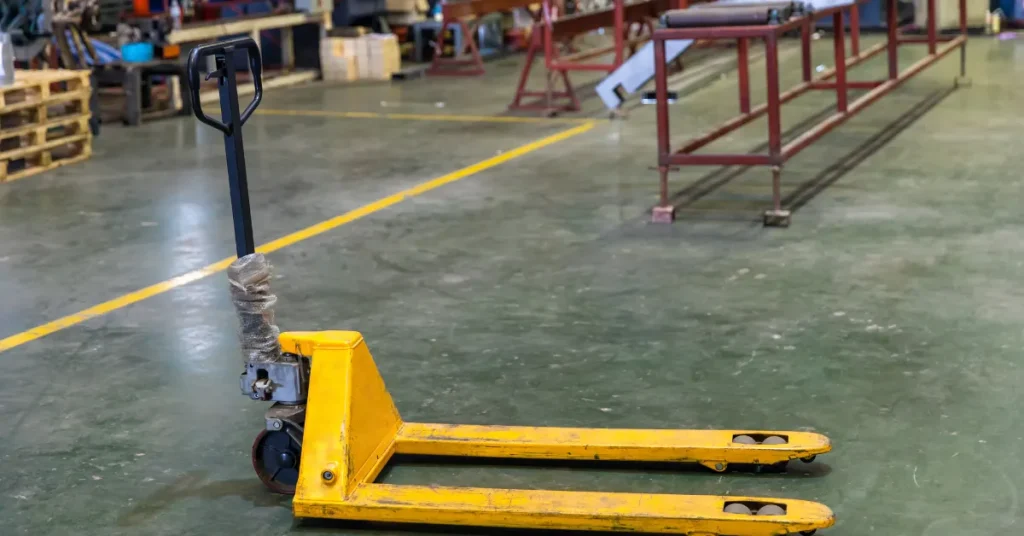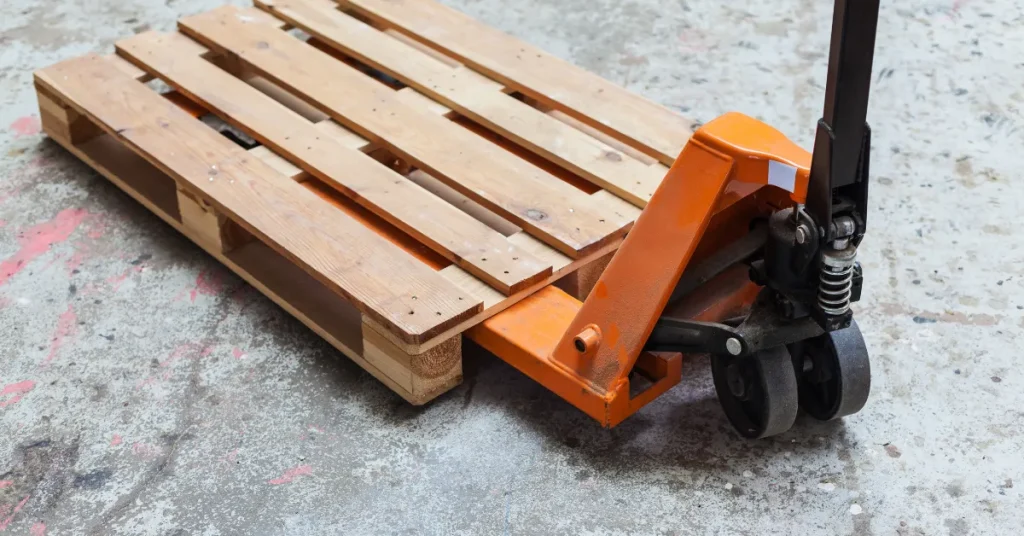The width of a standard pallet jack is typically around 27 inches. Pallet jacks, also known as pallet trucks, come in different sizes to accommodate various load requirements.
Offering a succinct snapshot, these material handling tools are essential in warehouses, retail centers, and manufacturing environments for transporting palletized goods with ease.
They are engineered for durability and maneuverability, with designs that include narrow versions for tight spaces. With compact, ergonomic handles and sturdy wheels, operators can efficiently move heavy loads across different terrains.
Their widths can range from 20 inches for mini jacks to over 36 inches for industrial models, allowing for a tailored fit for the job at hand.
The 27-inch width aligns with standard pallet sizes, ensuring compatibility and seamless operation within loading docks and storage aisles.

Pallet Jack Dimensions And Their Impact
Pallet jacks play an essential role in material handling. Given the vast variety of goods that they need to maneuver, they come in different sizes.
Their dimensions directly affect their maneuverability and load capacity. Understanding the typical sizes and factors influencing pallet jack width ensures efficient and safe operation in your workspace.
Typical Sizes Of Pallet Jacks
Pallet jack sizes can vary, but there are standard dimensions based on common pallet sizes. A typical standard pallet jack has a width of approximately 27 inches and a length ranging from 36 to 48 inches. Mini pallet jacks are available for smaller loads, often measuring around 20 inches in width.
- Standard Width: 27 inches (68.58 cm)
- Standard Length Options: 36 to 48 inches (91.44 to 121.92 cm)
- Mini Pallet Jack Width: 20 inches (50.8 cm)
Factors That Influence Pallet Jack Width
Several key factors determine the optimal width for a pallet jack:
- Load Size: Larger loads may require wider pallet jacks.
- Aisle Space: Narrow aisles need slimmer models for easier movement.
- Doorway and Ramp Width: Entry points dictate the maximum size of a pallet jack.
- Pallet Construction: The design of the pallets being used can affect the width required.
Every space and task demands a specific pallet jack size. Whether it’s a crowded warehouse or a compact retail space, picking the right dimensions prevents operational delays and enhances safety.
Space Optimization With Pallet Jacks
The importance of space optimization cannot be overstated in the high-paced logistics world. Pallet jacks play a pivotal role, particularly in confined areas. Understanding and utilizing the right sized pallet jacks help maximize efficiency and streamline operations.
Aligning Pallet Jack Size To Workspace
Choosing the correct sized pallet jack for your workspace is crucial. A tight space requires a compact jack, whereas larger areas can accommodate broader options. Here’s how to ensure the perfect fit:
- Measure your aisles and doorways for minimum width.
- Check the typical pallet size your operation handles.
- Opt for a pallet jack that balances maneuverability with load capacity.
Standard pallet jacks are roughly 27 inches wide, fitting the most common pallet size, but sizes can vary widely.
Strategies For Efficient Pallet Jack Storage
Storing pallet jacks effectively can free up valuable floor space. Implement these strategies:
- Dedicate a specific area for pallet jack storage.
- Use wall mounts or under-shelving spaces to keep jacks off the floor.
- Implement a check-in/check-out system to ensure orderly storage.
| Pallet Jack Type | Width (inches) | Storage Solution |
| Standard | 27 | Wall mount / Designated zone |
| Narrow | 20-21 | Under-shelving |
| Extra-wide | 33+ | Separate storage area |
Types Of Pallet Jacks And Their Widths

Understanding the various types of pallet jacks is vital for selecting the right one for your needs.
Pallet jacks, also known as pallet trucks, come in different sizes to accommodate various loads and work environments. Below we’ll explore the types of pallet jacks and their widths, ensuring a perfect fit for your workspace.
Manual Vs Electric Pallet Jacks
Pallet jacks are split into two primary categories: manual and electric. Manual pallet jacks are hand-powered, requiring physical effort to move and lift pallets. Electric pallet jacks, on the other hand, include a motor, making them easier to operate, especially with heavier loads.
- Manual Pallet Jacks are typically 27 inches wide.
- Electric Pallet Jacks usually start at 28 inches in width.
Specialty Pallet Jack Measurements
Specialty pallet jacks are designed for unique situations and loads. These include narrow, wide stance, and low-profile designs.
| Type of Specialty Pallet Jack | Width |
| Narrow Pallet Jacks | 20 to 21 inches |
| Wide Stance Pallet Jacks | Up to 33 inches |
| Low-Profile Pallet Jacks | 27 inches and up |
Selecting the right pallet jack width improves efficiency and safety. Choose based on your specific requirements and workspace limitations.
Navigating Through Tight Spaces
Navigating through tight spaces often poses a challenge, especially when handling a pallet jack. A standard pallet jack’s width can greatly impact its maneuverability within cramped areas of a warehouse.
Understanding the pallet jack’s dimensions and using specific techniques can make a significant difference. Efficient navigation preserves the integrity of stored goods and enhances worker safety.
Techniques For Maneuvering
- Plan your route: Look for clear paths and avoid obstructions.
- Assess pallet sizes: Match them with the jack’s width for easier handling.
- Opt for pivot movements: Rotate the jack slightly when turning.
- Pull, don’t push: This provides better visibility and control.
- Use mark guides: Place visual cues on floors to outline paths.
Dealing With Challenging Warehouse Layouts
Every warehouse has its unique layout, which can sometimes include narrow pathways and sharp corners. A slim pallet jack, about 21 to 27 inches wide, is ideal for such environments. Fork length also plays a crucial role.
| Pallet Jack Type | Width (inches) | Fork Length (inches) |
| Standard | 27-48 | 36-48 |
| Narrow | 21-27 | 36-48 |
To further manage demanding layouts:
- Identify tight spots: Mark areas requiring extra caution.
- Invest in adaptable equipment: Consider pallet jacks with a smaller chassis or single fork models.
- Train staff regularly: Teach proper techniques for tight space navigation.
Buying Guide For Pallet Jacks
Welcome to the ultimate buying guide for pallet jacks!
Whether you run a warehouse, a loading dock, or any facility that moves items, a pallet jack is essential. This guide makes choosing the right one simple and stress-free.
Considerations For Pallet Jack Width
Choosing the correct pallet jack width is crucial. It affects maneuverability and compatibility with pallet sizes. Standard widths are key to ensuring seamless operations. Here’s what to keep in mind:
- Workspace Size: Wider jacks need more room to turn.
- Pallet Size: Match the jack width to common pallet dimensions.
- Load Stability: Wider jacks might offer better balance for loads.
Comparing Brands And Models
Not all pallet jacks are equal. Different models suit different needs. Compare these factors:
Add more rows as needed
| Brand | Model | Width | Capacity | Wheels |
| Brand A | Model X | 27 inches | 5500 lbs | Polyurethane |
| Brand B | Model Y | 20.5 inches | 4500 lbs | Nylon |
Review user feedback and product reviews for real-world insights.
Select a reputable brand known for quality and durability. Focus on models with warranties and excellent customer service support.
Maintenance And Safety

Keeping a pallet jack in top shape ensures it works well and is safe to use. Regular maintenance and safety checks are key to avoiding accidents and prolonging the life of the equipment. This section outlines vital maintenance routines and safety instructions.
Routine Checks For Longevity
Your pallet jack demands consistent care. Follow these steps for optimal performance:
- Inspect the wheels for wear and tear.
- Check the handle and forks for any damage.
- Ensure the hydraulic oil level is sufficient.
- Tighten any loose bolts or nuts.
- Clean the pallet jack to remove debris.
By performing these tasks regularly, you help prolong the life of your pallet jack.
Safety Protocols And Width Restrictions
Safety comes first. Always adhere to these protocols:
- Operate within the pallet jack’s width capacity.
- Do not overload the pallet jack.
- Use the pallet jack on flat and stable surfaces.
- Wear appropriate safety gear while operating.
The standard width of a pallet jack ranges from 20 to 27 inches. Be aware of these measurements:
| Pallet Jack Type | Typical Width |
| Standard | 27 inches |
| Narrow | 20 inches |
Ensure hallways and aisles can accommodate these dimensions. Check width restrictions before using the pallet jack.
FAQs About How Wide Is A Pallet Jack
How Wide Are Forks On A Pallet Jack?
The width of forks on a standard pallet jack typically measures around 6 to 7 inches. However, fork width can vary based on the model and manufacturer specifications.
How Wide Is A Pallet Jack Tine?
Typically, the width of a pallet jack tine is approximately 6 to 8 inches. This size allows for stable lifting and handling of standard pallets.
How Much Clearance Is Needed For A Pallet Jack?
A pallet jack typically needs about 1 inch of clearance on either side to operate efficiently between pallets or in tight spaces.
How Wide Are The Wheels On A Pallet Jack?
Pallet jack wheels typically range from 2. 75 to 3 inches in width, providing stable support for lifting and moving loads.
Conclusion
Choosing the right pallet jack requires understanding its dimensions. The typical width can greatly impact your warehouse operations.
With the options available, ensure you select a size that aligns with your aisles and cargo. Proper selection will streamline your workflow and enhance productivity.
Keep width in mind for a savvy investment.
Resources:
1. https://www.psmagazine.army.mil/News/Article/1996292/pallet-jack-nsn/
